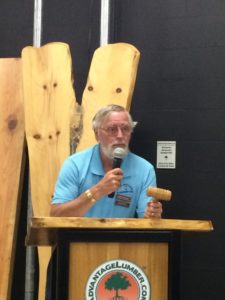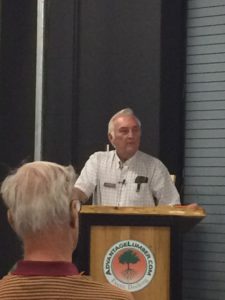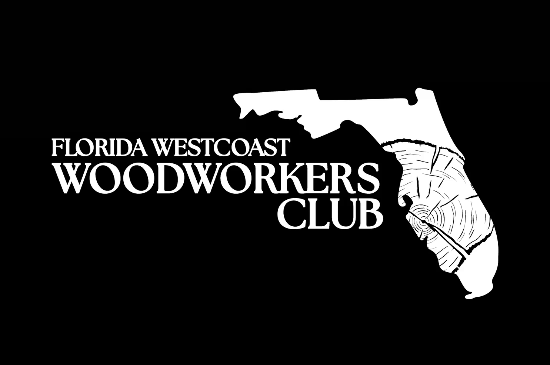 There were a total of 45 in attendance with 5 guests, when John Peasley opened the meetings. (PICK ON ANY PICTURE TO ENLARGE IT)
There were a total of 45 in attendance with 5 guests, when John Peasley opened the meetings. (PICK ON ANY PICTURE TO ENLARGE IT)
Announcements:
A mentoring program will be established so that members who have knowledge in a specific skill can help other members who want assistant in achieving that skill. Input from the members is needed to find mentors as well as those who would like to have a mentor work with them.
 Joe Mannke asked members for input to create a “recipe” book containing different finishes. He requested that members provide him a narrative or even pictures of finishes that they have found successful. The narrative needs to be specific, stating what exact products were used; ie. Minwax and not just wax. This information will be combined into a booklet that we can sell to other members for a $10 fee, as income to the club.
Joe Mannke asked members for input to create a “recipe” book containing different finishes. He requested that members provide him a narrative or even pictures of finishes that they have found successful. The narrative needs to be specific, stating what exact products were used; ie. Minwax and not just wax. This information will be combined into a booklet that we can sell to other members for a $10 fee, as income to the club.
Joe Mannke presented a poster that has been created for advertising and support of the club. Members were asked to take copies of the posters and display them in strategic places to advertise the club and also attract new members.
There are old woodworking magazines available to be given away. They are located by the entrance door to the room.
There will be no demo this month. The shop meet will be at Pat Kerr’s shop in Sarasota.
Presentation:
 Randy Maxey presented the topic of using and maintenance of hand planes. Randy was an editor for Woodsmith and ShopNotes magazines and is still a contributor to Woodsmith and Wood magazines. He teaches a course in hand tool joinery at Florida School of Woodwork in Tampa and has co-authored 2 books which he had available for sale. He distributed flyers tonight titled “Handplanes in the Workshop” which contained articles reprinted from Woodsmith and ShopNotes magazines.
Randy Maxey presented the topic of using and maintenance of hand planes. Randy was an editor for Woodsmith and ShopNotes magazines and is still a contributor to Woodsmith and Wood magazines. He teaches a course in hand tool joinery at Florida School of Woodwork in Tampa and has co-authored 2 books which he had available for sale. He distributed flyers tonight titled “Handplanes in the Workshop” which contained articles reprinted from Woodsmith and ShopNotes magazines.
Since not all shops have room for larger tool, his goal was to show us that items could be made with hand tools, specifically a plane. Randy became interested in using hand tools because of their accuracy. He provided suggestions for uses and maintenance of different types of hand plane. Glue manufacturers told him that the best gluing service was one that was created with a hand plane
 Randy showed us examples of “bench planes” which are numbered from 1 to 8 and vary in width as well as length. The higher numbers are used for larger projects. Standard bench planes have a 25 degree bevel with the bevel facing down. Only the leading edge is important to have a mirror sharp edge.
Randy showed us examples of “bench planes” which are numbered from 1 to 8 and vary in width as well as length. The higher numbers are used for larger projects. Standard bench planes have a 25 degree bevel with the bevel facing down. Only the leading edge is important to have a mirror sharp edge.  He suggested very slightly rounding off the corners to prevent gouging. He achieves this rounded off edge by increasing fingertip pressure on each corner of the chisel during the sharpening process.
He suggested very slightly rounding off the corners to prevent gouging. He achieves this rounded off edge by increasing fingertip pressure on each corner of the chisel during the sharpening process.
 Randy also described “low angle” planes which have the bevel up. The bevel angle on a low angle plane can vary according to application. The primary use of low angle planes is for end grains and knotty, hard to cut grain wood.
Randy also described “low angle” planes which have the bevel up. The bevel angle on a low angle plane can vary according to application. The primary use of low angle planes is for end grains and knotty, hard to cut grain wood.
To determine the proper blade depth, put the plane on a piece of wood, turn the knob until it grabs to determine the depth you want. You do not necessarily need to see the blade to make it work. When you are finished adjusting the blade snug up the depth adjusting knob so it is not loose.
The cap iron plate adds mass and must properly fit the blade (1/32” away). Adjust the throat so that there is a tight mouth opening  (about 1/16”) so the blade does not grab and tear the wood. Flattening of the sole plate on a plane is only necessary on the front and rear of the sole plate and across the mouth area. The whole rest of the sole plate does not need to be flat.
(about 1/16”) so the blade does not grab and tear the wood. Flattening of the sole plate on a plane is only necessary on the front and rear of the sole plate and across the mouth area. The whole rest of the sole plate does not need to be flat.
Old planes can be restored by removing all the metal parts and soaking them in Evaporust. If there are chips on the front of the mouth, the plane cannot be salvaged.
To sharpen a plane or a chisel, first flatten the back. Make a mark across the front edge and then swipe across the whetstone or sandpaper to eliminate the mark. Work thru the grits until achieving a mirror finish. Randy will flatten the whetstone before each use. It is important that the blade is held square so that it will be level all the way across. Slightly camphor the corners of the points on the bevel. Remove any imperfections, like dings on the edge, before sharpening the blade.
 Randy proved to be very knowledgeable and provided us with a new outlook on the uses of bench planes.
Randy proved to be very knowledgeable and provided us with a new outlook on the uses of bench planes.
Treasurers Report:
 We have 2 new members this month
We have 2 new members this month
Show and Tell:

 John Peasley Wedding intarsia and pelican, good project for beginners.
John Peasley Wedding intarsia and pelican, good project for beginners.
Randy Cooper Flip top tool stand and end grain cutting board

 Terry Bair Boxes from scrap wood
Terry Bair Boxes from scrap wood

 Mike Swart Chest for coin collection
Mike Swart Chest for coin collection
 Bryan O’Mahony Bowl made with gouges only, no lathe.
Bryan O’Mahony Bowl made with gouges only, no lathe.
 Mario Fajardo Bowl and candle holder
Mario Fajardo Bowl and candle holder







